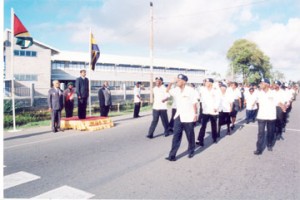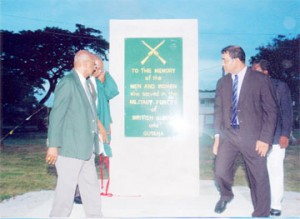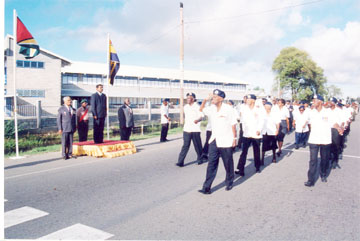The First World War (1914-1918) changed the course of human history in significant ways. For over 700 loyal British Guianese officers and soldiers who voluntarily enlisted and travelled overseas as members of the British West Indies Regiment, it was an unforgettable experience, but often for unexpected and unpleasant reasons.
Origins
Cedric Joseph’s The British West Indies Regiment, 1914-1918 recounts how shabbily West Indians serving in the British army were treated and how systematic official discrimination led to their disaffection. It was largely through the efforts and evidence of Captain A A Cipriani of Trinidad after the war that the West Indians were eventually exculpated from charges of military misconduct.

As a reaction to official mistreatment, sergeants of the Regiment, at a secret meeting in the sergeants’ mess at Cimino camp, Italy, in December 1918, formed an association called the ‘Caribbean League.’ Aimed at promoting closer union among the West Indian Islands after the war, the League’s impact was powerful enough for Joseph to suggest that:
“…the early post-war period witnessed the development of some of the League’s aims as seen in the general growth of the working-class movement, the organisation of trade unions, the demand for representative government and, here and there, calls for a closer union of the West Indian colonies. It is worth noting that two outstanding West Indian leaders in subsequent periods of reform had served in the war − Captain A.A. Cipriani of Trinidad and Sergeant N. W. Manley of Jamaica, Military Medal.”
This was a strong statement of the solidarity among soldiers from over a dozen different colonies ninety years ago.
Another consequence of the war was the formation of the British Guiana Legion. Veterans returning to the colony and being demobilised after the war ended in 1918, began meeting frequently from around 1920. These early meetings were held in their private homes and elsewhere, for example, at the Corinth Hall on Third Street Alberttown, and at the South Road home of Mr S A Rangaswamy − a veteran and one-time president of the Legion.
The Legion’s present headquarters was eventually constructed in the early 1950s owing to the exertions of Captain John Coghlan, MC, himself a World War I veteran who had served as judge advocate of the British West Indies Regiment in 1914-1918. Coghlan headed a select committee which convinced the commercial community and civil society to contribute to the headquarters project and which acquired land on Kelly Dam (now known as Carifesta Avenue) for it. The building was so commodious that it was used to accommodate members of the British army who were stationed in the country to maintain public order during the ‘Disturbances’ in the 1960s.
Objectives
The British Guiana Legion (renamed Guyana Legion after independence) was registered as a friendly society on April 26, 1926 under the Friendly Societies Ordinance. Its declared policy was “non-sectarian and non-political with respect to its aims, objects and activities.” Guided by its motto: ‘Lest We Forget,’ the Legion’s overarching aim over the years has been “To perpetuate the memory of the gallant men and women who suffered and died for the Commonwealth of Nations.” Its other objectives include: fostering and maintaining the spirit of self-sacrifice; assisting veterans and their widows and children; promoting and sustaining spiritual, educational, cultural, social and economic development; and raising funds to provide benevolent of financial assistance to its members.
The Remembrance Day observance is the most important annual activity. A solemn ceremony is held at the War Memorial in Georgetown (on the Sunday closest to the eleventh day of the eleventh month, marking the day in 1918 when the armistice agreement was signed to end the First World War) to commemorate the dead of the two World Wars. After a march past, veterans assemble at the Legion hall for a rare moment of national recognition, reunion and, most of all, for remembering. It is also the culmination of the ‘Poppy Appeal’ when money is raised by the sale of replica poppies – the blood red flowers which grew on one of the bloodiest battlefields of the First World War at Flanders in Belgium.
Organisation
The president of the republic – or, during the colonial era, the governor or governor-general – has traditionally accepted the honorary position as patron of the Legion. An executive committee comprising the president, general secretary, assistant secretary, treasurer and eight committee members, oversees the Legion’s day-to-day administration. There is also a legal adviser and a board of five trustees in whom are vested the Legion’s property. Elections for the committee are held at an annual general members’ meeting. The Legion’s first president was PEF Cressall, MC, and the present president is Colonel (ret) Carl Morgan, MSS.
The Welfare Committee visits sick and disabled members especially on holidays such as Remem-brance Day, Christmas Day and Independence Day. Three funds – Benevolent Fund, Provident Fund and Remembrance Day Relief Fund – provide modest relief to members and their families.
Initially, full membership was the exclusive prerogative of veterans who had seen at least seven days “active service” with the colours in any Commonwealth force during World Wars I and II. This is a finite number and, expectedly with the passage of time, veterans died and membership shrank. Mr Gershom Browne, the last known surviving Guyanese veteran of World War I, died in 2000 and nearly all of the fewer than 100 surviving veterans of World War II are in their 80s. The Legion’s common-sense decision has been to amend its rules to allow persons who did not participate in the two wars but had served in military organisations anywhere in the world after World War II to become members, provided that proof of honourable discharge is provided. Apart from ordinary members, there are associate, honorary, meritorious life and affiliate members and wives and children of veterans can join the Women’s Auxiliary Branch.
A non-profit, non-sectarian, non-governmental organisation, the Legion receives small annual subventions from the Royal (formerly British) Commonwealth Ex-services League and the Royal Canadian Legion. The Government of Guyana also gives a monthly subvention of a little less that $20,000. The Legion has always been plagued by its minuscule income and mounting expenses to care for its aging membership.
Speaking at the Legion’s traditional Remembrance Day reception in November 2003, then Minister of Home Affairs Mr Ronald Gajraj expressed appreciation for the veterans’ valuable service and pledged to increase the government’s annual financial subvention to the Legion. To loud applause, he told the ceremony “…we are prepared to increase that subvention substantially, going into the millions.” The millions, however, never materialised.

Affiliations
The Guyana Legion is a constituent member of the Royal Commonwealth Ex-services League. Founded in 1921, the League’s aim is to ensure that no pre-independence Commonwealth military veterans should be without help if in need. The debt is huge. Three million Commonwealth soldiers, of whom 440,000 were casualties, fought in the First World War; and four and a half million Commonwealth service men and women from Africa, India and the Caribbean, of whom 360,000 became casualties, participated in the Second World War. The League is a Commonwealth charity with 56 member organisations in 48 Commonwealth countries, where 65,000 eligible veterans and widows have been identified. Colonel Morgan, President of the Guyana Legion, represented Guyana at the League’s 30th Triennial Conference in Accra, Ghana, on July 19-23 this year. The Legion is also affiliated to the Royal Canadian Legion which provides some financial assistance.
The Guyana Legion is recognised as the ‘mother’ of all veterans organisations. Owing to the original restriction of ordinary membership to veterans of the two world wars, former members of the British Guiana Volunteer Force, Guyana Defence Force and Guyana People’s Militia were discouraged from joining. As a result, the Guyana Veterans Foundation was founded in 1995 to provide for the welfare of veterans of post-war military forces for whom it is at present constructing this country’s first national veterans’ home. The Foundation also constructed the country’s first monument dedicated ‘To the memory of the men and women who served in the military forces of British Guiana and Guyana.’
Representatives of the veterans’ organisations met Dr Roger Luncheon, who is Secretary of the Guyana Defence Board, in July 2000 when it was agreed that a single organisation should represent all military veterans in the country. Mr Neil Isaacs, AA, himself a World War II veteran and former president of the Guyana Legion, chaired the interim National Veterans Commission with this in mind and his report laid the foundation for amalgamating all veterans’ organisations.
This policy of amalgamation was reinforced with the election of Colonel Morgan – a former commandant of the Guyana People’s Militia and acting commander of the Guyana Defence Force – as the Legion’s president in February this year. He pledged to move faster towards removing barriers to enable the Legion to embrace all military veterans. The Guyana Veterans Foundation has already taken the first step to merge completely with the Guyana Legion.

